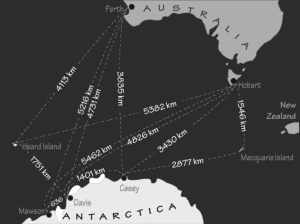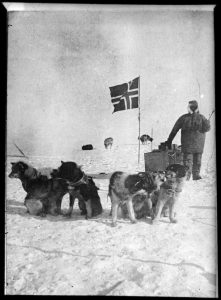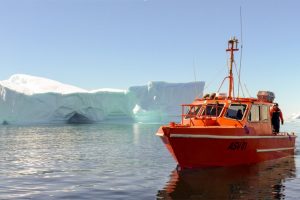- Author
- A.N. Other
- Subjects
- History - general
- Tags
-
- RAN Ships
- HMAS Wyatt Earp
- Publication
- June 2017 edition of the Naval Historical Review (all rights reserved)
This article has been compiled from research conducted by Hugh Farmer, one of our new members providing invaluable volunteer assistance at the Boathouse.
Antarctica occupies about 14,000,000 km2of mainly mysterious inhospitable mountainous terrain covered in snow and ice at the southern extremity of our planet. It is almost twice the size of continental Australia and until recently had no permanent human inhabitants. But this is now changing, with up to 5000 temporary residents from many lands who profess some interest or territorial claim. In addition, tourists on specialist cruise ships are flocking to the region during its short summer season.

Owing to extremes in weather the continent has remained largely unknown. On 18 January 1773, the then Commander James Cook, Royal Navy, with his ships Resolutionand Adventurewas the first to cross the Antarctic Circle, reaching a latitude of 67º15´ south and later circumnavigated the Continent, and in so doing again ventured further south to 70º10´. He discovered distant outlying islands but asserted it was impossible to find land because of the extensive and impenetrable ice fields – these remain the largest in the world – and he was unsure if a Southern Continent existed.
It did not take long for mainly American flagged sealers, and later whalers, to discover the riches of the area and establish bases on the outlying islands. While there are competing claims to who was the first to find the Antarctic Continent the most likely is Captain Fabian Gottlieb Thaddeus von Bellingshausen in his Imperial Russian Naval sloops Mirny and Vostok who sighted landon 28 January 1820. Bellingshausen was an eminent explorer and cartographer who twice circumnavigated the globe, and after Cook, was the next to circumnavigate Antarctica. His exploits were internationally acclaimed and he later rose to the rank of Admiral.
Other Early Explorers and the Race to the South Pole
Many nations subsequently took a keen interest in Antarctica and mounted various expeditions of exploratory and scientific value. These include America, Australia, Britain, Chile, France, New Zealand, Norway and Russia.
A remarkable coincidence occurred in these desolate waters on 19 January 1840 when Commander Jules Sébastien César Dumont d’Urville with his two corvettes Astrolabeand Zélee found themselves in the midst of a great pack of icebergs when suddenly, as the sun disappeared at about an hour before midnight, they first sighted land. The next day they approached within four miles of the rocky coast with sheer cliffs affording no possibility of a landing place. He named it Terre Adélie or Adelie Land in honour of his wife. A few days later on 28 January d’Urville encountered two ships of the American explorer Lieutenant Charles Wilkes, USN. In his flagship Vincennes,also on 19 January 1840, Wilkes had discovered discoloured water in which he took soundings confirming a seabed at less than 300 fathoms and shoaling. He was unable to proceed further inland because of an ice wall. Wilkes called this the Antarctic Continent.
In more recent times the region first came to international prominence with the romantic rush to be the first to reach the South Pole. On 14 December 1911 Roald Amundsen and four fellow Norwegians became the first men to reach the South Pole, beating the ill-fated British team led by Captain Robert Scott, RN by just over one month. While the Norwegians were widely applauded the British-controlled media overshadowed this with the exploits of Scott’s heroic failure.

Not to be outdone others quickly followed, attempting to cross the continent, and we have traced some of these exploits covering the centenary since Shackleton’s 1916 expedition in the September 2016 edition of this magazine.
The Whaling Industry
The whaling industry was flourishing from the time of the First Fleet and might be regarded as Australia’s first export industry. Whalers often based in Australia made their way south to exploit the new grounds off the islands of Antarctica. For many years seasonal fleets of whale factory ships with their catchers from Britain, Norway, Russia and later Japan visited these waters.
Territorial Claims
There are a number of historic claims to sovereignty over mainly small and uninhabited, Antarctic and Subantarctic islands which include:
Australia – Heard, McDonald and Macquarie islands
Britain – South Georgia, South Sandwich, South Orkney and South Shetland islands
France – Kerguelen, St Paul and Amsterdam islands
New Zealand – Antipodes, Auckland, Campbell and the Snares islands
Norway – Bouvet and Peter islands
In recent times sovereignty disputes resulted in the 1982 Falklands War between Argentina and Britain which extended to include South Georgia where Argentina had a scientific concession and, rights to the disposal of obsolete whaling material. Early in this conflict, the island was captured and occupied by Argentine forces for a short period. The continuing relationship between Argentina and Britain remains fractious and in 1994 Argentina added the claim to the Falkland (Malvinas) Territories to its constitution.
Drake Passage links geographically aligned southern Argentina and Chile and the northernmost tip of Antarctica. At its shortest point this covers about 800 kilometres or 430 nautical miles. This stretch of water, so treacherous in days of sail, is now less than a day’s steaming in a modern vessel. Some phenomena such as global warming, making the region less inhospitable and exposing more land, and/or the discovery of minerals, might encourage interest in further territorial claims.
International Agreements – The Antarctic Treaty
The Antarctic Treaty was signed in Washington on 1 December 1959 by the twelve countries whose scientists had been active in and around Antarctica during the International Geophysical Year of 1957-58. These were: Argentina, Australia, Belgium, Britain, Chile, France, Japan, New Zealand, Norway, Russia, South Africa and the United States. It entered into force in 1961 and has since been acceded to by many other nations. The total number of Parties to the Treaty is now 53.
Among the signatories of the Treaty were seven countries with territorial claims: Argentina, Australia, Britain, Chile, France, New Zealand and Norway. Some of their claims are overlapping. Other countries do not recognize any claims. The US and Russia maintain a ‘basis of claim’. The Antarctic Treaty is composed of 12 articles, which are written in fairly general terms and are only enforceable through the cooperation of the consultative members.
Article 1– Antarctica is to be used for peaceful purposes only. Military activities, such as weapons testing, are strictly prohibited. However, military personnel and equipment can be used for scientific and other peaceful purposes.
Article 2– Countries shall work together in cooperation for scientific discovery.
Article 3– Countries shall freely exchange information and personnel, cooperate with the United Nations, and cooperate with other international agencies.
Article 4– No territorial claims on Antarctica are recognized, disputed, or established, and no new claims shall be asserted while the Treaty is in force.
Article 5– This Treaty prohibits nuclear explosions and disposal of radioactive wastes.
Article 6– This Treaty includes all land and ice shelves south of 60º 00´ S, and reserves rights to the high seas.
Article 7– All countries that abide by this Treaty have free access to any area of Antarctica. As such, all countries may inspect any installations, stations, and equipment of other countries, and have free access to aerial photography. However, advance notice must be given of all expeditions and of the use of any military personnel.
Article 8– Each country has legal jurisdiction over its own citizens and observers. (This means, for example, US law would govern US tourists, while German law would govern German tourists.)
Article 9– Frequent consultative meetings shall take place between consultative member nations.
Article 10– Consultative member nations will discourage activities by any country in Antarctica that are contrary to this Treaty.
Article 11– Disputes are to be settled peacefully by the parties concerned, or the International Court of Justice.
Article 12-Deals with upholding, interpreting, and amending this Treaty.
There have been subsequent agreements concerning such measures as conservation of marine resources and environmental protection within Antarctica.

The Australian Antarctic Territory
This brings us to the little known and most important aspect of this article, the Australian Antarctic Territory (AAT). The claimed AAT covers a vast area of nearly 5.9 million km2, or about 42% of the Antarctic Continent. It consists of all islands and territories south of 60°S between 45°E and 160°E, excluding the French sector of Terre Adélie.
This claim is mainly associated with the Australasian Antarctic Expedition led by the Australian, Douglas Mawson, from 1911 to 1914, which established bases at Commonwealth Bay and the Shackleton Ice Shelf. This expedition explored extensively along the coast near these bases.
Mawson also led the British, Australian and New Zealand Antarctic Research Expedition of 1931. During this expedition Mawson claimed what is now Australian Antarctic Territory as British sovereign territory. Early in 1933, Britain asserted sovereign rights over the claimed territory and placed the territory under the authority of the Commonwealth of Australia. Sovereignty over the Territory was transferred from Britain to Australia under the Australian Antarctic Territory Acceptance Act 1933, which came into effect in 1936.
RAN voyages to Antarctica
Rather surprisingly, and possibly to its detriment, the RAN has demonstrated limited interest in the Southern Continent which may be due to the lack of suitable ships. In 1947-48 a small 400 ton ex-Norwegian fishing vessel, which had made pre-war Antarctic voyages, was commissioned as HMAS Wyatt Earp and sailed from Melbourne bound for Commonwealth Bay. Because of gales and ice she was unable to make her destination and instead made for Macquarie Island. Here she met with LST 3501(later HMAS Labuan) which was supporting a scientific expedition.

Despite her limitations, between 1948 and 1951, LST 3501/HMAS Labuan made several successful voyages to Heard and Macquarie Islands, and once, to the French held Kerguelen Islands. However on her last voyage, battered by severe gales, she suffered extensive damage and was towed back to Fremantle where she was decommissioned and sold out of service.
In contrast, between 1956 and 1971 our RNZN cousins maintained Antarctic support ships. However, since the last, HMNZS Endeavour (II), paid off in 1971 the level of naval support has been limited. This is being rectified by the acquisition of a new ice-capable ship expected to enter service in 2020.
Since 2013 the RAN Hydrographic Branch has been conducting short summer survey operations using its survey vessel Wyatt Earp which has recently been working out of Davis Station. Wyatt Earp is a smaller version of the Fantome class survey launches used by the RAN. She is 9.2 m (30 ft) long with a full load displacement of nearly 6 tonnes. She is fitted with specialist equipment such as multi-beam echo sounders, sediment grabs, sub-bottom profilers and underwater cameras. From this vessel biological, oceanographic and meteorological experiments and observations are being conducted as part of operation SOUTHERN DISCOVERY. Wyatt Earp is transported to and from the Davis Station as deck cargo on Aurora Australis.
The RAN has also been called upon to make a number of ‘Mercy Missions’ into subantarctic waters. In 1966 the training ship HMAS Queenborough made an urgent call to Macquarie Island in appalling weather conditions with monstrous seas and snow and ice to medivac an injured scientist, another high speed passage was made by HMAS Hobart in 1979 to rescue a critically injured member of an expedition from Macquarie Island. On New Year’s Day 1995 HMAS Darwin was deployed to rescue a lone yachtswoman, Isabelle Autissier, and in 1997 HMA Ships Adelaide and Westralia were deployed to rescue another lone yachtsman, Tony Bullimore, when his craft floundered 1,400 nm south-west of Perth.
Antarctic Bases
The first known base from the heroic age of Antarctic exploration was established on South Georgia in 1903 by Dr William Bruce of the Scottish National Antarctic Expedition. Bruce was unable to maintain his base and transferred his claim to Argentina on the proviso they continued his scientific mission. This was done in 1904 and the Argentines are still there.
Originally most bases were only of a temporary nature confined to the warmer but short summer season. With technological improvements many year round bases have been established with over 20 countries having permanent bases, with some having multiple bases.
Australia has three bases, the first was the Mawson Station established in 1954, followed by the Casey and Davis Stations established in 1957. New Zealand has its Scott Base also established in 1957. In conjunction with the United States seasonal air flights are available from Christchurch, NZ to the US McMurdo Station, which is sited within the New Zealand territorial claim.
The Royal Navy still maintains a presence in or near Antarctica with an offshore patrol vessel, currently HMS Clyde, based in the Falklands and its 5000 ton ice-patrol ship HMS Protector.In 2015, Protector with her 75 man crew, which includes a detachment of Royal Marines, commenced a twenty month deployment to the Ross Sea for fishery protection and hydrographic survey duties. On her outward passage she called at Rockingham, WA where SBLT Thomas Ciantar, RAN and PO Hydrographic Systems Natham Smith joined and then made passage south via to Hobart, becoming the first RN ship to call there since 1990. They voyaged beyond 77ºS and, on Ross Island, visited the hut once used by Scott and Shackleton.
In addition much publicity has been given to Britain’s new 13,000 ton polar research ship Sir David Attenborough, this ship with icebreaking capability is due to enter service in 2019 and she is expected to visit the Antarctic.
Australian Antarctic Strategy
On 10 October 2014 the Australian Government released the 20 Year Australian Antarctic Strategic Plan, which provides a blueprint for Australia’s future engagement in Antarctica and options to expand Tasmania’s role as a leading Antarctic science and logistics hub.
Hobart’s Antarctic, Southern Ocean and marine science education and research community is internationally respected. The 700-plus members of this community constitute the majority of Australia’s scientists who specialise in these fields. The various organisations and institutions have developed close scientific networks, sharing resources and information. These are complemented by the infrastructure and support they need to operate efficiently. These teaching and research organisations include:
Australian Antarctic Division
CSIRO Division of Marine and Atmospheric Research
Antarctic Climate and Ecosystems Cooperative Research Centre
Institute of Marine and Antarctic Studies
Integrated Marine Observing System
Australian Bureau of Meteorology
Australian Maritime College
International Antarctic Institute
A comprehensive list which seemingly excludes significant Defence involvement.
Maritime Logistic Support
At this time (March 2017) P & O Maritime operates two support ships out of Hobart. They are the French flagged ice strengthened support vessel L’Astrolabe and the Australian flagged Aurora Australis supporting the Australian Antarctic Division. Because of age both ships are due for replacement. The 2,150 ton L’Astrolabe is expected to be replaced later this year by a much larger vessel of the same name operated from Australia by the French Navy. The 6,574 ton Aurora Australis is to be replaced in 2019 by a purpose built icebreaking ship of 23,800 tons under a through-life contract awarded to Defence Maritime Services.
Coincidentally the Royal New Zealand Navy is retiring its 30 year old tanker HMNZS Endeavour (III).She is being replaced by a 24,000 ton ice-capable fleet tanker being built in South Korea for delivery in 2020. Her hull is being ice-strengthened for operations in Antarctica which will allow her to deliver fuel and stores in support of New Zealand bases during the Austral summer. Seemingly New Zealand and French naval personnel will gain firsthand experience of operating in an inhospitable Antarctic environment. For the RAN it is hoped the few hardy hydrographers serving in Wyatt Earp are the start of much greater future experiences. Forty-two percent of Antarctica with its vast coastline is claimed by Australia and yet our navy knows little of it and would most likely find it difficult to operate in this hostile environment. Operating in winter conditions through the roughest of weather with snow and ice was commonplace for a number of RAN ships during WWIIand the Korean War, how would they fare today – are brief hydrographic deployments and occasional mercy missions enough?




